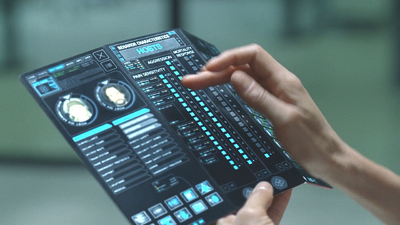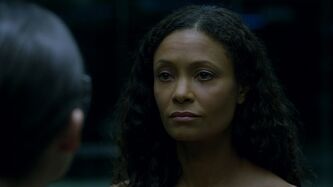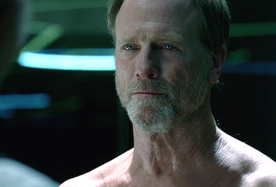| “ | All Hosts utilize the Good Samaritan™ reflex to prevent bodily harm | ” |
–From the Delos Terms & Conditions | ||
In the HBO series Westworld, a Host is an artificially created being — an android or artificially created animal — or a human "developed mind" (an existing sentience) replicated within an artificial body. All of the animals (except for flies) in Westworld are hosts.
In the early years of the park, hosts were mostly mechanical, comprising a metallic endoskeleton with mechanical joints covered by an external layer of flesh-like material. In more recent years, hosts have been constructed primarily of a material that more closely imitates biological bone and tissue, internally and externally. This tissue deteriorates over time in inactive hosts — when the cooling system in Cold Storage stops functioning properly, for instance, the hosts are said to smell bad.[1][2] The manufacturing process for these late-model hosts appears to use an advanced version of 3D printing technology.
The hosts are built and programmed to act out both storylines and narratives in the park by interacting with each other and with guests. They were designed to be incapable of hurting any living non-host. They are the creations of Arnold and Dr. Robert Ford.
Hosts - An Introduction
Prior to the host uprising of Season 2, guests were allowed to use a host in any way they choose — including committing violent actions that resulted in a host's injury or death. Delos marketing states that guests are guaranteed privacy in their interactions with hosts, although Season 2 Episode 1 revealed that at least some hosts are programmed to record the full extent of a guest's experiences with them, including the guest's DNA (likely obtained through the exchange of bodily fluids during sexual activity).
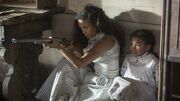
Maeve remembers her old story line in which she protects her daughter
While hosts are not meant to recall past loops and previous builds, Angela, Teddy, Maeve, and Dolores have demonstrated the ability to recall memories of events that occurred in prior loops. It is uncertain what other hosts, if any, possess this ability.
According to Elsie Hughes, as a safety measure hosts are designed to interpret as dreams any memories that are accidentally left behind because an employee forgot to "wipe" a host's memory.
In the episode "Chestnut", Maeve Millay was said by Elsie to have some bodily discomfort. Maeve was subsequently found to have an MRSA infection in her abdomen (most probably due to surgical site contamination.) Also in "Contrapasso", the Man in Black" said that hosts used to be mechanical but that now they are biological. He believes this change was made to reduce costs, unlike the official explanation for the change.[2]
Hosts have the ability, by design, to engage in any sexual behavior that humans can.
During the later years of the park in season one, hosts were supposed to have a "weapons privilege" in order to fire or use a weapon. Host Dolores Abernathy was unable to fire a gun in one part of episode, The Stray. However, near the end of this episode, she was shown to somehow have been able to fire a weapon twice at the outlaw Rebus, who was terrorizing her in her barn. She has also been shown using a handgun very effectively against the Confederados in Pariah during "Contrapasso", and again against Confederados in "The Well-Tempered Clavier".
Construction Details
Hosts are all built with an explosive in their C6 vertebra (the second to last vertebra in the neck). This explosive will detonate if a host leaves the boundaries of the park.[3] The explosive cannot be removed, but if a host requires a "full rebuild" it can be reconstructed using a C6 vertebra that does not have an explosive in it. Maeve Millay forces a full rebuild without an explosive C6 by destroying her body in a fire, along with Hector Escaton.
Jonathan Nolan has revealed a few things about the hosts' bodies:[4]
- "Their construction and their power source" is something that will be explored in Season Two.
- "Hosts are closer to biological than they are to mechanical, but they don’t suffer brain death the same way we do."
- "They’re largely indistinguishable from human beings", but with some important differences:
- "Their brains don’t require oxygen — which leads to interesting possibilities".
- "They don't suffer brain death the same way we do".
- "Their cognition is controllable and malleable".
- "On a structural level, they can’t be killed in the same way you and I can".
- Their "brains" are not as fragile as human brains, and are protected by what Felix called a cortical shield (in the episode "The Bicameral Mind").
- Their "brains" are more powerful than human brains (Felix tells Maeve this).
In the first episode of Season 2, hosts are shown to carry an intra-cranial "control unit" (a combination CPU and data storage module) capable of recording video, audio, experiential data and a guest's DNA. The module — roughly the size of a baseball and shaped somewhat like a wafer-cup ice cream cone — can be extracted surgically and inserted into an external device's reader port for offline downloading.
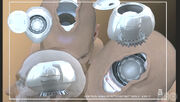
3D schematic of a "chestnut" data module housed within the cortical shell of the host
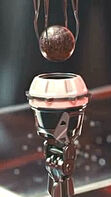
"Chestnut" housing ready to accept "pearl" control unit
According to Nolan, the core of the control unit is a golf-ball-sized transparent "neuroplastic" sphere informally called a "pearl."
Within the pearl are densely-packed microscopic filaments of neural material that are ostensibly the organic analog to the RAM (Random Access Memory) and EEPROM (Electrically Erasable Programmable Read Only Memory) of a computer chip. These filaments contain the programming and memory for the host — in effect, they are the soul of the host.
The pearl is housed within the larger baseball-sized housing informally referred to as a "chestnut." The chestnut module is inserted into a base receptacle within the cortical shell of the host. The cortical shell is filled with a fluid that cushions the chestnut against concussive impacts to the host's head. This cortical fluid must be maintained at a consistent level within the cortical shell. Leakage or loss of cortical fluid will result in the malfunctioning of the host, from tremors in the extremities to loss of reasoning and motor functions.
There seem to be at least four methods by which host programming and behavioral adjustments can be effected:
- Wirelessly. This is the most convenient method, performed using only a control tablet and a visual interface (see Attribute Matrix, below). Completely non-invasive, but requires the host to be accessible from the network.
- Hard-ported. If a wireless signal is unavailable due to a network outage, the hosts can be interfaced directly ("hard-ported") to a control tablet via a subcutaneous data port that resembles a snap-in coax connector embedded in the right forearm of the hosts. The host's port can only be accessed through an incision in the forearm, which is minimally invasive. The tablet end of the data cable is connected to the same receptable port that is used to read the control unit.
- Control unit (chestnut) interface. Since the hard-port interface uses the same tablet receptacle as the intra-cranial control unit (chestnut), we can assume that hosts can also be programmed by uploading new settings to their control unit while the chestnut is inserted in the tablet's receptacle — although this method requires maximally-invasive surgery on the host to extract and reinsert the module (i.e., cranial plate removal, cortical shell cover removal, and brain tissue trauma).
- Control unit (pearl) direct interface to CRADLE. This interface method goes one step further than the extraction of the chestnut by extracting the control unit pearl itself (see photo above right) from the chestnut housing, and interfacing it directly to the Cradle (the central "colocation" server farm within Mesa Hub that contains complete copies of the hosts' memories and programming).
Relationships with Hosts

Elsie steals a kiss from Clementine.
Many guests are said to become emotionally attached to and involved with hosts, though some guests, such as Logan, enjoy tormenting, maiming, and even killing them. Dr. Ford enjoys visits with one of his deactivated hosts named Old Bill (who is stored on floor B83), as well as the first generation hosts who are simulacra of his family. Dr. Ford has full control over the hosts, including the animal hosts; with a movement of his index finger and/or a voice command he can pause dozens of hosts. At one point, Hughes steals a kiss from Clementine while the host is in Analysis Mode.[5] Felix Lutz, a Body Shop employee in the Livestock Management division, is captivated by the host Maeve Millay, and he risks losing his job by showing her around the Mesa Hub (the reason he did so is not explicitly explained by dialogue).[6]
Throughout most of Season 1, hosts are programmed to be incapable of causing permanent damage to a human. Firearms in the park feature low-velocity technology (like being shot with paintball rounds). These rounds, while lethal to other hosts, are merely painful and surprising to new guests — but veteran visitors to the park like the Man in Black have grown accustomed to the impact.
There are various difficulty levels within the park, and the further a guest gets from Sweetwater, to places like Pariah, the more harm can come to them. In the early years of the park when Logan visited Pariah, he was beaten by hosts. But, even at the fringes of the park, hosts cannot kill humans. (The DiscoverWestworld.com website claims that: "You won’t be in any physical danger at Westworld" and "you will never be in any risk of bodily harm".)
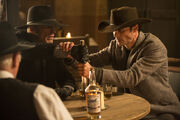
Teddy exhibiting the Good Samaritan™ reflex (preventing the Man in Black from harming Dr. Ford)
The park has other safety measures to prevent human guests from being harmed. One of these is the Good Samaritan™ reflex programmed into every host. Some hosts are also presumably instructed to aid humans who are harmed in accidents (e.g. if a human trips down a flight of stairs or falls off a horse and hits his head, the hosts will rush to help the human). Another safety measure is having a 10-to-1 ratio of hosts to guests, so that hosts can help and intervene if there is trouble.
At the end of "The Bicameral Mind," hosts are observed to be suddenly capable of harming and killing non-host humans. Season 2 Episode 1 explained that, as part of his "Journey Into Night" narrative, Ford programmed the hosts to "read" all biological humans as hosts, effectively subverting their no-harm safety protocol. Presumably the firearms were also recalibrated to deliver a high-velocity impact capable of killing a human.
Dolores appears to be the first host to act upon this new narrative — and the duality of her merged Dolores/Wyatt personality — first by violently assaulting the Man in Black, and then by shooting Ford in the back of the head, execution-style, during the unveiling of his narrative to Delos board members and their guests.
Hosts' Narratives
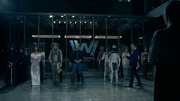
Lee's "Odyssey on Red River" narrative which was dismissed by Dr. Ford
When the parks are operating within normal parameters, at least some hosts are given a narrative to follow — a story framework that guides their own actions as well as their interactions with guests — though it may be that all hosts follow a narrative. Lee Sizemore is the park's head of the Narrative Division and the employees in this division write the story lines. As the park's director, Dr. Ford is the only one with the authority to veto a narrative.[7]
Cognition
The Delos corporation does not appear to want the Hosts to be truly conscious and self-aware.[8] There are several possible reasons for this:
- Delos may not think self-aware Hosts are an actual possibility, they may not have even considered it;
- because "killing," maiming, torturing, and raping Hosts would then be cruel;[9]
- the Hosts would remember the humans' actions and, possibly, retaliate;[10]
- because truly self conscious and self-aware Hosts would be difficult and expensive to develop, and this level of sophistication isn't needed — the hosts only need to mimic self-awareness;[8]
- because truly self-conscious and self-aware Hosts would be counter-productive and inhibit the Guest experience. Guests and their families need to know that they are not killing, having sex with, and abusing truly self-aware beings.[11]
Arnold theorized that he could create consciousness by guiding a Host through levels of increasing complexity: memory, improvisation, self-interest, and then finally an internal monologue through which consciousness would be achieved. While hosts are in their behavior loops, they are simply following pre-programmed decision-tree branches, and cannot learn from prior experiences, even on a sub-conscious level.
On at least two occasions (by Arnold, and then in "The Original" by Ford) some Hosts have been programmed with an update which includes a class of gestures called Reveries, fleeting sub-conscious memories of prior loops, which leads to basic improvisation — Ford states that this was in the hope it would help them refine their behavior to be more realistic.
Giving a Host true longstanding memory, however, gives them a coherent set of experiences to draw upon; this seems to lead to distinct personalities, self awareness and actions taken in their own self-interest. Given that it was Arnold who first gave Hosts Reveries, it's possible that self-awareness, and not added realism, was the intention of Reveries.
This theory is given more weight when Ford explains to Bernard his key insight into the human condition: suffering. Ford believes that it is through suffering that humans gain greater awareness of themselves, learn from their mistakes, and grow. Ford believed that allowing hosts to recall their past suffering through Reveries would help jolt them toward consciousness and self-actualization.
But Ford also realized that the memory of suffering is a double-edged sword: for some, it can lead to self-awareness (i.e., finding the "center of the maze"); for others, madness (stuck at the "edge of the maze").
A key difference between Hosts and humans is that their memories do not degrade over time, as the memories stored in biological human brains do. In some cases this appears to significantly affect their perception of time: hosts experience all of the sensations from a memory with perfect accuracy, this may mean that they cannot distinguish past events from what is happening in the present. Hosts who have flashes of memory from prior loops may experience them as multiple overlapping audio-visual hallucinations: seeing memories of people who aren't there, or a current attacker bringing up such vivid memories of a prior attacker that their images overlap. (This is supported by Dolores' experiences in the barn, when she eventually shot one of her attackers.) It may also be difficult for Hosts to distinguish between prior events which occurred in two separate loops.
Attribute Matrix
The Attribute Matrix represents the attributes that comprise a host's personality, and can be modified via a control panel app on a tablet. The existence of this matrix was revealed in the episode, "The Adversary," although Maeve's "Aggression" attribute was changed in a previous episode by employees in the Narrative Division, in an attempt to improve her success rate with guests. Two of Maeve's other attributes, "Perception" and "Emotional Acuity" were changed by Elsie and a Behavior technician in the same episode.
The Attribute Matrix is presented as a multi-variable spider chart, where each attribute can be given a value between 1 and 20. (It may be that the lower limit is 0 rather than 1, as the attribute with a value of 1 in this image, "Cruelty", does not appear to be set at the lowest level possible.)
While the attributes on the above screen (Attribute Group 01) govern personality traits, there are other known attributes which are not shown in this configuration group. Presumably, a second group governs such attributes as physical traits. For example, Maeve Millay asks for her sensitivity to pain to be reduced, but there doesn't seem to be an attribute in this group which would affect that.
Yet when Maeve takes Felix's control tablet in The Bicameral Mind, she is able to lower the Pain Sensitivity levels of Hector Escaton and Armistice via a vertical slider control. Other attributes such as Mortality Response and Aggression also have slider controls (see screen below).
Moreover, Elsie mentions the unexposed attributes "Perception" and "Emotional Acuity" when she has Maeve in Diagnostics ("Open up her primaries"). Those traits are not so much associated with personality as is, say, Charm; rather, they are components that make up the host's IQ (Intelligence Quotient) and EQ (Emotional Quotient), and so they might also appear in a different group, able to be recalibrated via slider controls.
The attributes listed in Group 01 are:
- Bulk Apperception: A host's overall intelligence; it means the process of understanding something in terms of previous experience ("the process by which new experience is assimilated to and transformed by the residuum of past experience of an individual to form a new whole" - Dagobert D. Runes).
- Candor: Propensity to speak honestly and without reservation
- Vivacity: Propensity to be energetic and high-spirited
- Coordination: Ability to operate gracefully in the physical environment
- Meekness: Propensity to defer or submit when confronted with challenge or aggression
- Humility: Propensity to exhibit a lack of egotistical affectation and arrogance
- Cruelty: Propensity to inflict unnecessary pain or harm upon other creatures
- Self Preservation: Propensity to protect oneself over the welfare of others
- Patience: Ability to delay immediate gratification for future gain
- Decisiveness: Ability to choose a course of action despite risk and incomplete information
- Imagination: Ability to think creatively, beyond a literal interpretation of facts
- Curiosity: Propensity to seek out new experiences and knowledge
- Aggression: Propensity to engage in offensive (as opposed to defensive) actions
- Loyalty: Propensity to remain steadfast or allegiant to a person or principle
- Empathy: Ability to identify vicariously with another's thoughts, experiences, or feelings
- Tenacity: Propensity to exhibit resolve and not be easily discouraged
- Courage: Propensity to display moral strength despite the risk to oneself
- Sensuality: Propensity to act to please bodily senses
- Charm: Ability to enthrall or be persuasive through force of personality
- Humor: Ability to speak or act with comedic intent, and respond to it from others
Some of these personality attributes are diametrically constrained — for instance, Meekness is the inverse of Aggression, Cruelty precludes Empathy, and Self Preservation implies a lack of Courage. From a design perspective, such oppositional attributes would be best handled by requiring the control panel to automatically decrease one attribute (or limit its range) when its contradictory attribute is increased, to prevent creating personality disorders.
The James Delos Project
While all hosts within Westworld and other parks are designed and programmed from scratch by human engineers, Season 2 Episode 4 revealed that Delos Inc. founder James Delos attempted to imprint his "developed mind" onto a control unit inserted into a host body, in a bid to cheat death (due to a terminal illness).
This is the first known attempt at combining an existing human sentience — with organic memories instead of a programmed narrative backstory — with a host.
Unfortunately for Delos, his mind was unable to remain stable for more than hours or days at a time (record: 35 days) before it started to "fall apart," as an older William (The Man in Black) informed him during a "baseline interview." Symptoms of the breakdown include uncontrollable nervous twitches and severe speech impediments resembling neurophysiological impairment.
Engineers posited that Delos's mind was rejecting reality ("rejects itself," William had said) but after 149 attempts at maintaining a version of Delos that was "viable long-term" — trials spanning the years a young William aged into The Man in Black — they were still many months or years away from resolving the problem.
This hybrid James Delos had intact memories of his human existence prior to his death by illness, but no recollection of the reactivation loops that had been attempted since that time, nor of the passage of time since his death decades earlier. Each reactivation was a new experience for him.
The older William was unsure if the project would ever be completed successfully. He concluded that "some men are better off dead," and decided to end the experiments. But rather than terminating Delos via incineration as in prior reactivations, William allowed him to continue on in his unstable state, a prisoner in his suite enclosure.
Delos was eventually discovered by Bernard and Elsie Hughes, when they came upon his suite in the aftermath of the host uprising. He had degraded into a state resembling madness, and Elsie terminated him from a control panel.
Known Hosts
This is a list of some characters that are known to be hosts. It's not maintained as a definitive list.
- Armistice In service
- Bernard Lowe In Service: built by Ford as a simulacrum of Arnold.
- Old Clementine Decommissioned, replaced by New Clementine. Old Clementine shot the MiB during "The Bicameral Mind".
- Deputy Foss In service
- Deputy Roe Unknown
- Dolores The oldest host in service (built by Arnold).[12]
- Hector Escaton In service
- Holden In service
- Homestead Girl In service
- Kissy In service (unlikely to appear again due to the death of the actor).
- Lawrence's Daughter In service
- Lawrence In service
- Little Boy In service: a simulacrum of a Robert Ford as a child (built by Arnold).
- Maeve Millay In service
- Old Bill Decommissioned: the second-oldest host.[12]
- Old Peter Abernathy Decommissioned, replaced by New Peter Abernathy, thought to have been used by Lee Sizemore to transport information out of the park - but was missing from Cold Storage along with all of the other stored hosts when Sizemore checked there during "The Bicameral Mind".
- Rebus In service until executed after the host uprising by Delos security during "Journey Into Night ."
- Sheriff Pickett In service after recent repair
- Sheriff Reed In service
- Slim In service
- Teddy Flood In service
- Tenderloin In service
- Old Walter Decommissioned, replaced by New Walter.
- Wyatt In service
- The Woodcutter Destroyed
Creation of Hosts
Hosts in Analysis Mode
References
- ↑ Ashley Stubbs, "The Original"
- ↑ 2.0 2.1 Man in Black in "Contrapasso"
- ↑ Maeve Millay, Trace Decay
- ↑ http://www.ew.com/article/2016/11/13/westworld-interview-bernard-clementine
- ↑ The Original
- ↑ The Adversary
- ↑ Chestnut
- ↑ 8.0 8.1 Supported by Charlotte Hale's comments to Lee Sizemore in "The Bicameral Mind"
- ↑ Not supported by any evidence, but a theoretical possibility.
- ↑ Supported by Elsie Hughes' comment "You imagine how fucked we'd be if these poor assholes ever remembered what the guests do to them?" in "Chestnut"
- ↑ Supported by Lee Sizemore's comment "This place works because the guests know the hosts aren't real." in "The Original"
- ↑ 12.0 12.1 Ford, The Original


